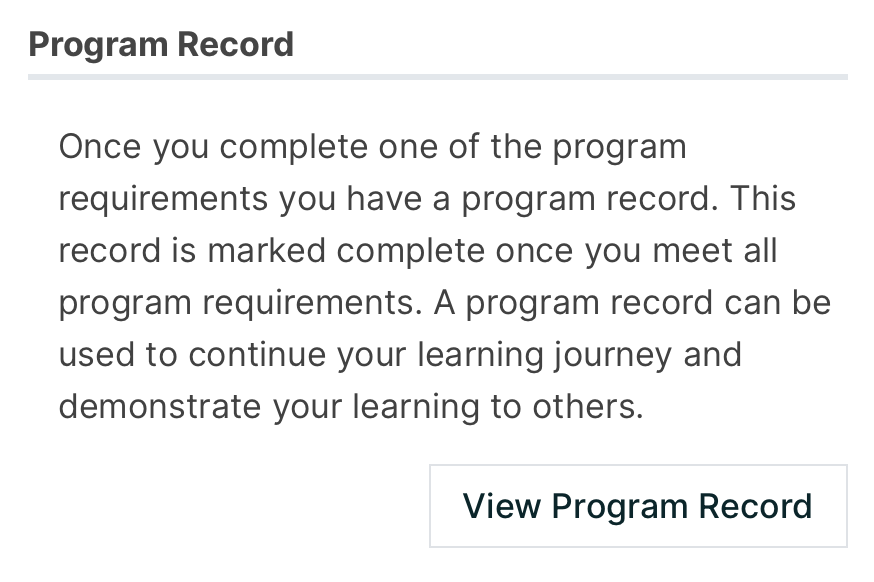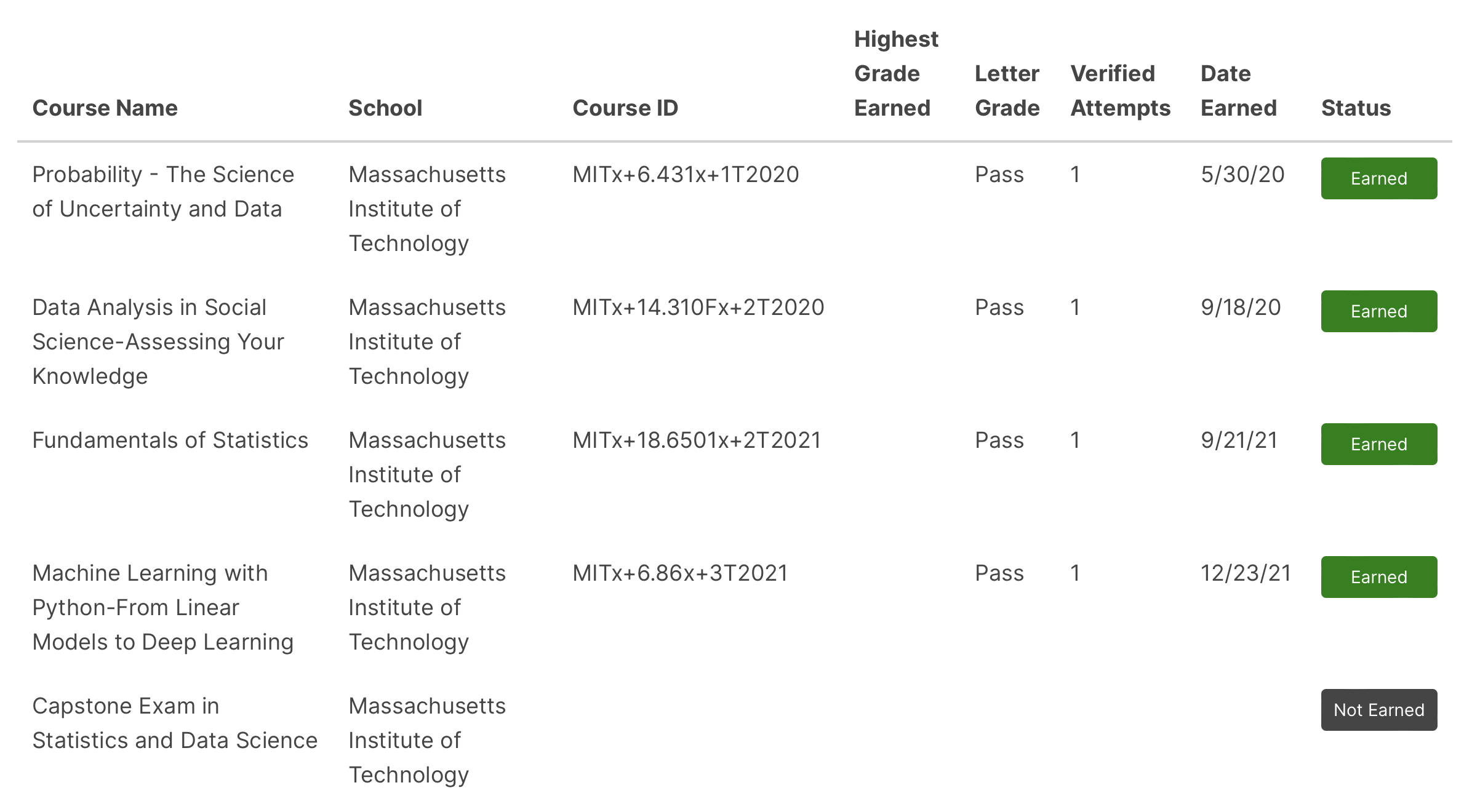SDS Capstone Exam
My resolutions for 2022 include succeeding the Capstone Exam for the MM program in SDS. Although there already exist an extensive description and FAQ, allow me to summarize its essence and mechanics.
TL;DR, if you are interested about the preparation of cheat sheets, feel free to jump directly to the last section of this introductory page. Otherwise, feel free to read below a little more detail, to refresh the contents of the Capstone Exam and general requirements.
For syllabi breakdown, see below:
- Probability and statistics
- Data analysis and machine learning (TBD)
Capstone Exam
The Capstone Exam is a set of cumulative exams on all content in the three core courses and one elective course in the MicroMasters Program in Statistics and Data Science (SDS). Students are eligible to take this exam only if they have passed and obtained the certificates for three core courses:
- 6.431x Probability-the Science of Uncertainty and Data (Prob);
- 18.6501x: Fundamentals of Statistics (Stats); and
- 6.86x Machine Learning with Python-From Linear Models to Deep Learning (ML)
and one elective course in the SDS:
- 14.310x/Fx: Data Analysis for Social Scientists (DASS); or
- 6.419x: Data Analysis: Statistical Modeling and Computations in Applications (DASM).
NOTE: in my case, I passed DASS during the second term 2020 and plan taking DASM in the next run (May-Aug 2022).
So, few things to bear in mind:
- The Capstone Exam consists of four 2-hour virtually-proctored exams, roughly corresponding to the above mentioned courses. One exam part will correspond to the elective course taken by the learner. The Capstone Exams are much closer to in-class exams, when students will be tested on the internalized knowledge. They are comprehensive, and students will need to think quickly.
- Students will need to refer to the syllabus of each course for the list of topics covered. The level of difficulty will be comparable to the homework problems. However, unlike the in course homework and exams, there may be some questions that mix concepts from different courses.
Grading Policy and Program Record
The four exams will be divided in two parts, which are open in different periods with different proctoring rules.
| Part | Exam | Format | Exam Syllabus |
|---|---|---|---|
| 1 | Prob | Multiple Multipart Problems | Prob (except Units 7 and 8) |
| 1 | Stats (Theory) | Multiple Multipart Problems | Stats and Prob (Units 7 and 8) |
| 2 | Stats | Multiple Multipart Problems, Data Analysis requiring R/Python | DASS or DASM (only Module 1) |
| 2 | ML | Multiple Multipart Problems | ML |
Each exam counts for 25% of the total grade of the Capstone Exam course. Students will need to obtain a total score of at least 50% to pass the Capstone Exam.
While the certificate of the Capstone Exam (as well as the certificates of all courses in the program) does not include the percentage or the letter grade, the sharable program record on our edX profile will include both the percentage and the letter grade for the Capstone Exam (A, B, C, or F).
To access your Program Record, go to your Programs Dashboard, select your SDS track and scroll down until you see View Program Record.

Here, you should see your complete record, together with the option of sharing a link or sending your record to accredited partners (such as MIT PhD Program in Social & Engineering Systems, and Harvard Extension School)

Above is an example of a Program Record. In your case, you should be able to see the actual grades obtained in each completed course.
Preparation and cheat sheet
Cheat sheets are optional, but making one helps to review, connect, and summarize ideas. It is important that cheat sheets are developed by students themselves. Below, the main rules for the cheat sheet:
- Students are allowed to use 2 cheat sheets for the Part 1 exams, and pre-upload and use 2 more cheat sheets for Part 2. For the avoidance of doubt, this means that students will be allowed to prepare up to 4 cheat sheets in total, choose 2 to use in Part 1, and use all 4 of them in Part 2;
- Each cheat sheet must be letter-sized (8.5” x 11”) or A4 (29.7cm x 21cm) and can be double-sided;
- Students will be asked to upload cheat sheets as PDF for the first 2 exams and cheat sheets for the last 2 exams by a specified deadline.
Bear in mind that SDS staff emphasizes that only cheatsheets that have been fully processed and digested will be useful during a 2-hour exam. Also, cheatsheets should be based on topics rather than courses (remember mixed concepts from different courses).
In addition to accessing on-screen the cheat sheets uploaded before the corresponding exams open, during Part 1 exams the students will also be allowed to access:
- All 4 courses runs which students had enrolled in and passed, including the existing posts in the discussion forum;
- Basic calculator;
- Selected online translators, namely Google translate, Fanyi Youdao and Bing Translator;
- Several online calculators and computing software, including Google and WolframAlpha.
In addition to the above, during Part 2 students will have access to:
- R/Python IDE and code editors (e.g. R Studio, PyCharm, Spyder, Jupiter Notebook);
- Spreadsheet programs (e.g. Excel, Numbers, LibreOffice);
- R/Python documentation.
NOTE: although the above list does not expressly mention Visual Studio Code or R packages/Python libraries we have been using throughout the courses (such as dplyr, tidyr, ggplot2, numpy, scipy), there should be no reason for not being able to use and access them.
Collaborative cheat sheet preparation?
One thing that definitively helped me reaching this point was the possibility to interact with fellow students and engage in active discussion, while strictly abiding by the code of conduct. In particular, the most significant component of that learning experience was sharing the ideas and trying to explain to others your view of a given topic.
Therefore, provided that each cheat sheet has to be developed individually, I believe there is a productive way to add the collaborative component to the preparation of cheat sheets; which is the ambition of this blog.
Recall that SDS staff recommends that cheat sheets should be:
- fully processed and digested, to be useful during 2-hour exams;
- short, to fit into letter/A4 size double-sided sheet (roughly, one sheet per exam);
- based on topics, rather than courses, to accommodate the mixing of concepts;
- exhaustive, to address all homework/problem set exercises.
In addition, I think it is useful keepin in mind that it will be good if cheat sheets are:
- cross-referential, to allow prompt access to the relevant page in the course website. This is because we will have access to the entire course material;
- simple, comprehensive and in an easily accessible form, to stimulate quick thinking. This means that instead of writing down the entire derivation, it maybe more efficient focusing on the general concept (i.e. definition formula) and the final result. Any particular derivation could be achieved thanks to online tools like WolframAlpha;
My impression is that apart the first bullet, the others can benefit from a collaborative approach, without affecting the overarching objective that cheat sheets should remain the result of an individual activity. In particular, a constructive debate regarding how courses syllabi could be broken down into topics and what is the minimum set of formulas/concepts/pseudo-code that cover the maximum number of exercises provided in the finger exercises, homeworks, midterms and finals.
Without further ado, in this post you will find my first attempt to breakdown syllabi of Prob and Stats, before I start developing cheat sheets focused on the topics.
Posts
-
Linear Regression
-
Bayesian statistics
-
Hypothesis Testing
-
Methods of estimation
-
Foundation of Inference
-
Introduction to statistics
-
Bernoulli and Poisson Processes
-
Further topics on r.v.
-
Continuous Random Variables
-
Discrete Random Variables
-
How I customized the theme of this blog
-
Counting
-
Conditioning and Independence
-
Probability Models and Axioms
-
Probability and Statistics syllabi breakdown
-
How I added the comments section
-
How I created this blog
subscribe via RSS